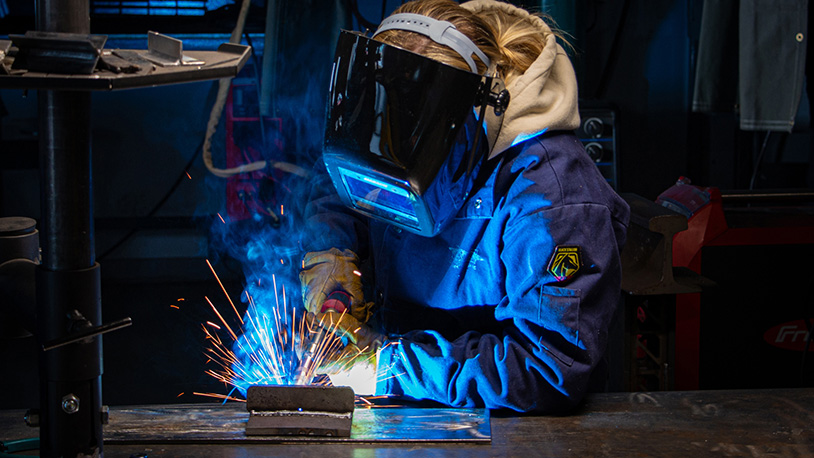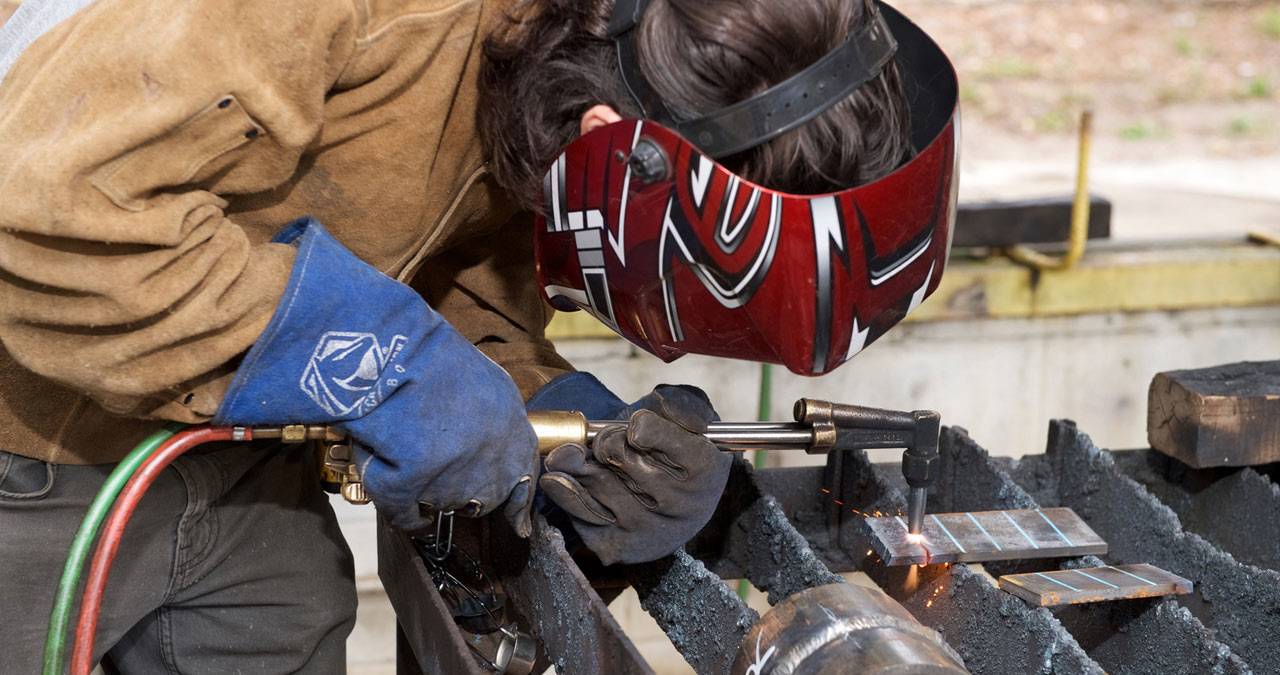Everything about Welding: Trick Insights Into Techniques and Best Practices for Success
Welding incorporates a range of techniques, each fit for details products and applications. Comprehending these methods, such as GMAW, SMAW, and TIG, is necessary for accomplishing ideal outcomes. Furthermore, the right devices and safety methods can not be overlooked. As prep work and repairing play vital duties in the welding procedure, understanding these elements can greatly boost the quality of the final item. What are the vital factors that ensure a successful weld?
Comprehending Different Welding Strategies
Welding methods include a selection of approaches, each suited to certain applications and products. Amongst the most typical techniques are Gas Metal Arc Welding (GMAW), Secured Steel Arc Welding (SMAW), and Tungsten Inert Gas Welding (TIG) GMAW, additionally recognized as MIG welding, is prominent for its rate and versatility, making it ideal for thin materials. SMAW, or stick welding, is preferred for its simpleness and effectiveness in outdoor environments, especially with thicker metals. TIG welding provides precision and control, making it appropriate for detailed job and non-ferrous steels (Welding). Each technique has its special advantages and factors to consider, allowing welders to choose the best technique based on the job's demands, product kind, and wanted end results. Understanding these techniques is necessary for effective welding
Important Welding Devices and Tools
While various welding strategies need specific abilities, the appropriate devices and devices are equally necessary for achieving quality outcomes. Vital welding equipment includes welding devices, which differ depending upon the method-- such as MIG, TIG, or stick welding. Safety gear, including handwear covers, aprons, and helmets, guarantees security and convenience during the procedure. In enhancement, fixtures and clamps aid safeguard materials in position, ensuring accuracy in welds. Consumables like welding rods, cable, and shielding gas are likewise vital parts that influence the high quality of the weld. Furthermore, devices such as cutters and mills facilitate surface prep work and post-weld ending up, adding to an expert end result. Purchasing top quality tools ultimately enhances the efficiency and performance of welding jobs.
Security Practices in Welding
Correct safety methods are crucial in the welding market to protect workers from possible dangers. Welders have to wear proper personal protective devices (PPE), consisting of headgears with appropriate shading, gloves, and flame-resistant clothes. Appropriate air flow is vital to reduce direct exposure to hazardous fumes and gases generated throughout the welding procedure. In addition, employees ought to be educated in the proper handling of welding tools to avoid crashes. Fire precaution, such as maintaining flammable products far from the welding area and having fire extinguishers readily offered, are necessary. Normal evaluations of devices and offices can aid recognize prospective hazards prior to they cause mishaps. By sticking to these safety and security methods, welders can develop a safer working atmosphere and reduce dangers related to their trade.
Readying Products for Welding
Preparing products for welding is an essential step that greatly influences the top quality and stability of the end product (Belgrade Fabrication). Proper preparation includes cleansing the surfaces to get rid of contaminants such as oil, dirt, and rust, which can compromise the weld. Methods such as grinding, sanding, or making use of solvents are generally employed to achieve a tidy surface. Furthermore, ensuring that the products mesh comfortably is essential; gaps can lead to weak welds. It's likewise important to take into consideration the alignment and positioning of the components, as this will affect the simplicity of welding and the last end result. Choosing the suitable filler product and ensuring compatibility with the base metals is vital for attaining solid, long lasting welds.
Tips for Getting High-Quality Welds
Achieving top quality welds needs interest to detail and adherence to finest techniques throughout the welding procedure. Appropriate joint preparation is necessary, ensuring surface areas are tidy and free from contaminants. Picking the suitable filler material and welding method based upon the base steels is essential for perfect bonding. Keeping constant traveling rate and angle while welding can advertise and prevent flaws harmony. In addition, controlling warm input is important; extreme heat can cause bending and deteriorated joints. If essential, on a regular basis inspecting the welds during the process enables for prompt changes. Finally, using ideal post-weld treatments, such as cleansing and stress and anxiety relief, can improve the durability and integrity of the weld, ultimately ensuring an effective result.
Fixing Typical Welding Issues
Welding typically presents challenges that can impact the top quality and stability of the end product. Common problems such as porosity, irregular weld grains, and overheating can arise, each needing particular fixing strategies. Comprehending these issues is necessary for welders to boost their skills and attain perfect outcomes.
Porosity Troubles Discussed
Porosity can usually be neglected, it stays a critical concern in welding that can compromise the integrity of a completed product. Porosity describes the visibility of small gas pockets within the weld bead, which can compromise the joint and lead to early failing. This issue typically arises from impurities, moisture, or improper shielding gas protection throughout the welding process. To alleviate porosity, welders ought to verify that the base products are dry and clean, use suitable protecting gases, and maintain consistent welding criteria. Routinely evaluating the devices and environment can also aid identify potential problems prior to they manifest in the weld. Dealing with porosity properly is vital for accomplishing strong, long lasting welds that fulfill quality criteria.

Irregular Weld Beans
Irregular weld beads can significantly impact the quality check here and toughness of an ended up item. Different factors add to this problem, consisting of improper travel speed, inaccurate amperage settings, and irregular electrode angles. When the welder moves also swiftly, a bead might appear narrow and lack penetration, while moving too slowly can trigger excessive accumulation. Additionally, utilizing the wrong amperage can lead to either undercutting or extreme spatter, both of which compromise weld honesty. The welder's technique, such as inconsistent lantern motion, can additionally bring about unequal bead look. To mitigate these problems, welders need to concentrate on preserving steady, regulated activities and guaranteeing proper equipment settings to attain uniformity in their welds. Uniformity is vital to achieving solid and trusted welds.
Getting Too Hot and Warping Issues
Extreme heat during the welding process can result in considerable overheating and contorting concerns, impacting the architectural stability of the work surface. These problems typically materialize as distortion, which can compromise positioning and fit-up, making more assembly challenging. Aspects contributing to overheating consist of the selection of welding parameters, such as voltage and travel rate, along with the sort of product being welded. To mitigate these concerns, welders ought to preserve consistent traveling speed and ideal warm input while monitoring the workpiece temperature. Furthermore, pre-heating or post-weld warm therapy can help relieve tensions triggered by fast air conditioning - Montana Mobile Welding and Repair. Normal examination and adherence to finest techniques are vital in protecting against overheating and guaranteeing the long life and reliability of bonded structures
Often Asked Inquiries
What Are the Profession Opportunities in the Welding Sector?
The welding sector uses diverse profession chances, including positions as welders, engineers, educators, and inspectors. Professionals can work in production, construction, aerospace, and auto fields, profiting from strong demand and competitive wages in numerous duties.
How Can I Improve My Welding Speed Without Sacrificing High Quality?
To improve welding speed without giving up quality, one should practice reliable techniques, maintain devices, optimize setups, and improve hand-eye control. Normal training and seeking comments can additionally significantly add to attaining quicker, top quality welds.
What Accreditations Are Available for Welders?
Various qualifications exist for welders, consisting of those from the American Welding Society (AWS), the National Center for Building And Construction Education And Learning and Research Study (NCCER), and various industry-specific organizations. These qualifications boost employability and demonstrate skill effectiveness.
Just How Does Welding Affect the Qualities of Metals?
Welding influences the buildings of steels by modifying their microstructure, which can result in adjustments in toughness, ductility, and solidity. Warmth input and cooling prices throughout the procedure significantly impact these material features.
Can I Bonded Dissimilar Metals Together?
